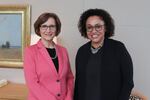
Oregon Congresswoman Suzanne Bonamici, left, and National Endowment for the Arts Chair Dr. Maria Rosario Jackson at the Portland Art Museum. Jackson and Bonamici toured the state, speaking with arts organizations about how to provide more access to arts education.
Steven Tonthat / OPB
National Endowment for the Arts Chair Dr. Maria Rosario Jackson met with Oregon arts leaders this week to discuss the need for more access to art in the state.
Congresswoman Suzanne Bonamici organized the listening and learning tour.
“I planned this visit to showcase all of the work that we’re doing and also to have a conversation with the community about how we can promote equity, engagement, especially in more rural communities,” says Bonamici.
The NEA provides funding for various arts organizations across the country through the federal government.
Over the last five years, the NEA provided more than $12 million in federal grants to bolster Oregon’s arts and cultural institutions.
Nominated by President Joe Biden and confirmed by the U.S. Senate in 2021, Jackson serves as the NEA’s 13th Chair and is the nation’s first Chair of Black and Mexican descent.
Prior to her current tenure, Jackson spent 30 years as an arts advocate, most recently as a professor at the Herberger Institute for Design and the Arts at Arizona State University.
“If we don’t figure out how to integrate the arts into how we think of building healthy, opportunity-rich communities, where all people can thrive, we will be stuck,” says Jackson. “So figuring out how to do that is paramount.”
Visits included the Patricia Reser Center for the Arts in Beaverton and the performing arts theater Bag&Baggage Productions in Hillsboro.
But Dr. Jackson was quick to point out that she was especially inspired by her visit to the Arts & Communication Magnet Academy (ACMA) in Beaverton.

Oregon Congresswoman Suzanne Bonamici, left, and National Endowment for the Arts Chair Maria Rosario Jackson speak with students from the Arts & Communication Magnet Academy.
Courtesy Lauren Jin
“To see the students so confident and on a pathway surely to something fantastic, whether it’s in the arts or outside of the arts, to have been trained in a way where their creativity is nurtured, their imagination is expanded, and their sense of possibility is real. That’s huge.”.
Even so, Jackson admits challenges loom even at a model creative campus like ACMA.
“There’s a waitlist. Immediately I wanted to know how many of these kinds of schools exist around the country. How available are they to all kids, especially underserved communities where the need for those kinds of experiences are even greater?” Jackson says.
Geography, explains Congresswoman Bonamici, is also a continuing issue for families living in the state’s more rural areas. Regular visits to local museums or galleries aren’t always easy.
“Kids often don’t have access in schools. Some do and some don’t. Adults often find that they can’t access art.”
Bonamici also says that arts education as a whole is often ignored in favor of more practical disciplines like math and science.
“People just do not understand the benefits. They think ‘Why do we need art? Most people won’t be artists.’” she says. “They don’t understand that there’s research showing that the arts enhance other disciplines as well.”
To potentially address the issue, Bonamici introduced the Arts Education for All Act, which supports arts education for children in grades K-12 and in juvenile justice programs.
“When all students have access to the arts, that’s closing gaps. Even if they do not become artists, they can learn about empathy, storytelling, and learn about the importance of understanding each other,” she says.
The last stop on the learning tour was at the Portland Art Museum’s “Perspectives” exhibit, where arts and civic leaders discussed the importance of expanding opportunities for artists of color, especially those who have been affected by the pandemic.
“Making sure we’re connecting people with grand opportunities and support and making sure that artists get paid for their work,” says Bonamici.
“We have a lot of big challenges ahead of us. We need creative people to help us find solutions to overcome these challenges. The arts can help with that, but also can help us heal.”
